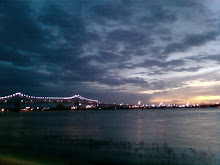Here is the public precinct in all its glory:

The civic center was largely constructed in the 1970s upon the desires of then Mayor-President Woodrow "Woody" Dumas to construct a centralized local government center in the grandiose poured concrete fashion so common to the era. (Notwithstanding this, various city departments are still to this day located in various off-site locations, some which are not even located downtown.) However, local government has made its presence felt in this general area for some time. Future trends portend continued and even expanded public use at this location, pursuant on voter approval of the nearly $1 billion (!) bond at the polls on November 4.
Yellow dot: Old State Capitol - The Old State Capitol served as the seat of Louisiana state government from 1847 to 1862, and again from 1882 to 1932. A historic and beautiful structure modeled in a non-traditional neo-Gothic medieval castle style, it serves today as a museum and tourist attraction, and a marquee landmark for the city. While not strictly part of the civic complex, it abuts the complex closely and is surrounded by its dark works on its east and south sides, making an incongruous sight among the civic center's modern Brutalist structures. The historic wrought iron fence which surrounds the property (recently restored) prohibits communion between the former state precinct and the local governmental center.
Red square: Old Parish Courthouse - Dating from the 1920s, it comprises the oldest local portion of the complex. Its red stucco roof and generous shaded setbacks from the street set this structure apart in terms of grace and class. Currently it serves as quarters for city court and its enforcement arm, the constable's office.
Green square: Municipal Building - Upon the creation of the consolidated City-Parish government in 1949, a need for additional public space beyond the old parish courthouse and old Baton Rouge City Hall was ascertained. The former City Hall, located nearby on the corner of North Blvd. and Fourth Street now houses the BR City Club.

The Municipal Building was opened in the 1950s - a five story structure that, for a time, unbelievably managed to contain nearly the entirety of City-Parish government. (This was the era before the expansionist public sector became endemic on the local level here.) To-day, somewhat half-forgotten, it serves merely as the HQ for the EBR Sheriff's Office and the City-Parish Department of Public Works, with some other DPW offices occupying the balance of the space.
Yellow square: Governmental Building - The centerpiece of the 1970s public consolidation, this ten story butt ugly Brutalist structure is the City-Parish's current seat of government, containing the offices of the Mayor-President, the Metropolitan Council chambers, and various other city departments and agencies including the assessor, parish attorney, information services, registrar of voters, clerk of court, and others.

Five of its ten floors are occupied by the 19th Judicial District Court, and thus this building serves as the de facto EBR courthouse.
Purple square: Baton Rouge River Center - Formerly known as the Centroplex, the River Center is BR's convention facility. The arena portion is an original 1970s structure while the building to the south is a 1990s-2000s addition.
Adjacent to the Governmental Building also lies the Performing Arts Center (purple dot) and River Center branch library (orange dot). An open air venue, Galvez Plaza (green dot) is used from time to time for concerts and public events. Finally, Repentance Plaza (red dot) serves as a tasteful green space which serves as a 'lawn' for the complex (though not a heavily used lawn at that).
Magenta square: Future 19th Judicial District Courthouse - The construction of a modern 12 story courthouse, now underway and slated to finish in 2010, will mark the greatest certain change to the civic complex in a generation. The courthouse will permit the 19th Judicial District Court and the Clerk of Court to vacate the Governmental Building (to be rechristened as City Hall) and allow this space to be occupied by other city agencies currently located in off site locations, which can then be sold off, rendering their maintenance costs no longer a burden to the public purse.
Blue and black squares: Future hotels for dickhead conventioneers -Private investment in new convention center hotels will be instigated (or so our politicians claim) with the passage of the bond issue in November. This will spur even greater alterations in the civic center built environment if approved. The bond issue is slated (among other things) to pay for River Center expansion and expansion of the parking facilities in the area. The current location of the public defender's office is slated to be the site for the first proposed hotel; this will eliminate the attendant structure as well as a tasteful Creole cottage type structure on the corner of St. Ferdinand and Louisiana Streets. The East garage (blue dot) will be expanded in place, and the West garage (blue square) will be demolished to make way for the second proposed hotel. The West garage will be replaced by constructing a new South garage south of Government Street between St. Phillip and St. Louis Streets south to Europe Street, and would connect to the River Center via an elevated walkway.
This garage construction would entail demolishing several historic homes where low income folk live, as well as a semi-historic 1950s era one story office structure (now vacant) and a historic home now occupied by the law firm of the former EBR district attorney. Finally, it would close off and obliterate a one block long historic brick-surfaced portion of France Street that climbs the bluff:

Another insult to Beauregard Town looms.
Change looks to come to the civic precinct - expect more pictures as it unfolds!



No comments:
Post a Comment